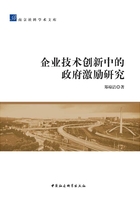
第四节 本章小结
本章首先对技术创新与技术创新中的政府激励概念进行辨析和厘定,还比较了创新、R&D活动等相关概念。在文献梳理和研究的基础上,对新古典经济理论、新制度经济学理论和国家创新体系理论中有关技术创新与政府激励的思想进行了总结,最后给出了本书的理论研究框架及相关理论假说。
[1] Mansfield,E.,Industrial Research and Technological Innovation,NewYork:Norton,1968.
[2] Freeman,C.,The Economics of Industrial Innovation,2nd ed,London:The MIT Printer,1982,pp.4-7.
[3] P.R.Mueser,“Identifying Technical Innovations”,IEE Transactions on Engineering Management,Vol.32,No.4,1985,pp.164-168.
[4] Stoneman P.,“Innovation and Growth:Schumpeterian Perspectives”,Journal of Economic Behavior & Organization,Vol.7,No.2,1986,pp.220-222.
[5] Burgelman R. A.,et al.,Strategic Management of Technologies Cause Great Firms to Fail,China Machine Press,1998.
[6] Freeman Christopher,Technolgoy Policy and Economic Performance:Lessons from Japan,Pinter Pub.Ltd.,1987.
[7] 许庆瑞:《技术创新管理》,浙江大学出版社1990年版。
[8] 汪应洛:《充分发挥大学在技术创新中的作用》,《中国科技论坛》1990年第4期,第14—16页。
[9] 柳卸林、简明钰:《如何通过国际兼并提高技术创新效率——京东方的并购与创新》,《河北科技大学学报》2007年第12期,第73—82页。
[10] 傅家骥等:《技术创新学》,清华大学出版社1998年版。
[11] OECD,OECD Frascati Manual,Fifth Edition,1993,pp.116-121.
[12] OECD,OECD Factbook Environmental and Social Statistics,2008.
[13] Sahal Devendra,Patterns of Technological Innovation,London,Don Mills,Ontario;Amsterdam,Tokyo:Addison-Wesley,1981,pp.34-42.
[14] Fagerberg J.,Manuel Mira Godinho,Innovation and Catching-up,Oxford:Oxford University Press,2004.
[15] 梁琦:《江苏省企业技术创新研究》,《江苏社会科学》1997年第5期,第182—188页。
[16] 胡珑瑛等:《大中型大工业企业技术创新分析》,《科学学与科学技术管理》2000年第12期,第43—45页。
[17] 朱新轩等:《上海国有大型工业企业技术创新综合评价》,《华东科技》1998年第3期,第16—18页。
[18] 王大洲、关士续:《我国国有大中型企业技术创新与制度创新现状分析》,《中国软科学》2000年第4期,第32—37页。
[19] 秦宇:《中国工业技术创新经济分析》,科学出版社2006年版。
[20] 陈振明:《政策科学》,中国人民大学出版社1998年版。
[21] Arrow,K.J.,“The Economic Implications of Learning by Doing”,The Review of Economic Studies,Vol.44,No.5,1962,pp.109-114.
[22] Romer,P.,“Endogenous Technological Change”,Journal of Political Economy,Vol.98,No.5,1990,pp.71-102.
[23] David,P.A.,Mowery,D.,Steinmueller W. E.,“Analyzing the Payoffs from Basic Research”,Economics of Innovation and New Technology,No.2,1992,pp.73-90.
[24] Barro,R.J.,“Government Spending in a Simple Model of Endogenous Growth”,Jouranl of Political Economy,Vol.98,No.2,1990,pp.103-125.
[25] 查理德·R.纳尔逊:《美国支持技术进步的制度》,G.多西等编:《技术进步与经济理论》,经济科学出版社1992年版。
[26] 郑琼洁:《政府科技激励与技术创新效率研究——基于行业要素禀赋的分析视角》,《南方经济》2014年第12期,第66—81页。
[27] Veblen,T.,The Theory of the Leisure Class:An Economic Study of Institution,Aakar Books,1899.
[28] Commons,J.R.,“Institutional Economics”,The American Economic Review,Vol.6,No.26,1931,pp.35-45.
[29] Harold Demsetz,“Toward a Theory of Property Rights”,The American Econmic Review,Vol.57,No.2,1967,pp.13-20.
[30] 参见胡代光《西方经济学说的演变及其影响》,北京大学出版社1998年版。
[31] Coase,R.H.,“The Nature of the Firm”,Economica,Vol.4,No.16,1937,pp.386-405.
[32] Alchian,A.A.,Demsetz,H.,“Production,Information Costs,and Economic Organization”,American Economic Review,Vol.62,No.5,1972,pp.777-795.
[33] Demsetz,H.,“Information and Efficiency:Another Viewpoint”,Journal of Law and Economics,Vol.12,No.1,1969,pp.1-22.
[34] North,D.C.,Thomas,R.P.,The Rise of the Western World:A New Economic History,Cambridge:University Press,1973.
[35] Freeman,C.,Christopher,F.,Technology Policy and Economic Performance:Lesson from Japan,Pinter Publishers London,1987.
[36] Nelson,R.,“National Innovation Systems:A Comparative Analysis”,University of Illinois at Urbana-Champaign's Academy for Entrepreneurial Leadership Historical Research Reference in Entrepreneurship,Vol.8,No.3,1993,pp.35-45.
[37] Lundvall,B.A.(Ed.),National Systems of Innovation-Towards a Theory of Innovation and Interactive Learning,London,1992,pp.129-145.
[38] Patel,P.,Pavitt,K.,“National Innovation Systems:Why They Are Important,and How They Might Be Measured and Compared”,Economics of Innovation and New Technology,Vol.3,No.1,1994,pp.34-54.
[39] 秦宇:《中国工业技术创新经济分析》,科学出版社2006年版。